Because ground temperature provides an important cue for cicadas' emergence, and spring temperatures have trended higher since the great-great-grandparents of this year’s Brood X cicadas emerged in 1970, that cue is likely to arrive sooner.
Cicadas typically emerge in force when ground temperatures reach approximately 64°F degrees, often after a steady rain. Some places with Brood X cicada concentrations have already reached that temperature threshold. The 10-day average temperature across the Brood X region is running 8.0°F warmer than at this time in 1970, and 1.1°F warmer than in 2004.
To help show the connections to warming, Climate Central analyzed the date when the critical emergence temperature is reached in U.S. counties expecting Brood X waves and counties that have other populations of cicadas. The local graphics and national map tell the story: warmer temperatures mean this year’s Brood X specimens may emerge as much as a month earlier than past generations.
METHODOLOGY
We calculated soil temperature using daily high temperature (Tmax) and daily low temperature (Tmin) according to the formula at https://cicadasafari.org/soiltemp.html. We computed the daily average (average of Tmin and Tmax). We then computed the mean of the previous two and previous three days. These were then averaged together.
We applied this approach to Tmin and Tmax data from gridMET and from GHCN weather stations. Cicada counties and counties with Brood X were from the US Forest Service (https://data.fs.usda.gov/geodata/edw/datasets.php?xmlKeyword=cicada).
To compute the trends in cicada emergence day depicted in the map, we found a 5-by-5 array of gridMET pixels surrounding the center of each county. We then computed the first day of each year (1981-2020) when the 64°F threshold was reached. We fit a linear trend to each of the 25 time series from each county, and then averaged the trends together.
The ground temperature in the Brood X zone was calculated for 19 stations in Brood X counties with more than 10 years of data.
